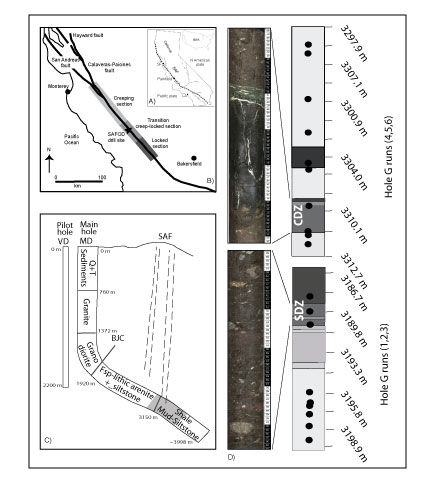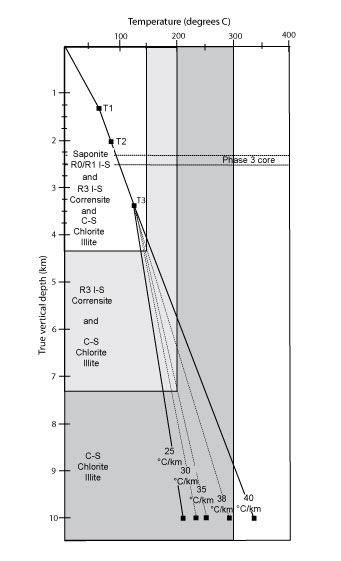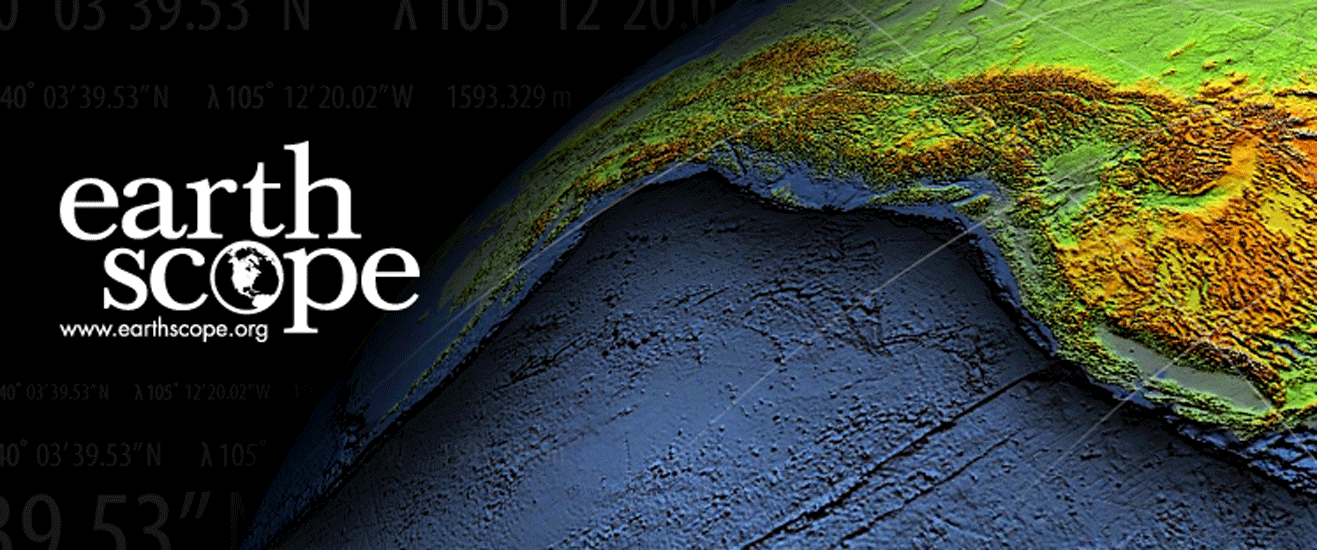Anja M. Schleicher, Ben A. van der Pluijm, Laurence N. Warr - Winter 2013
Drilling into an actively creeping section of the San Andreas Fault (SAF) is a fascinating milestone in earthquake science, as it provides direct information on the composition and mechanical properties of the rocks that are deformed in a fault zone (Hickman et al. 2004). The project offers an opportunity to test contrasting hypotheses on properties, behavior and strength of the SAF, which have been actively debated. The cores retrieved from the San Andreas Fault Observatory at Depth (SAFOD) drill hole in Parkfield, California show intensively sheared and foliated rocks in the two creeping sections of the fault, containing different smectitic clay minerals. This occurrence supports our hypothesis that clay phases convey fault weakness along creeping segments. While constraining the behavior at relatively shallow levels, deeper sections of the fault may also be guided by clays that are stable to greater depths than smectitic illite.

In our latest study, we focused on the stability and the formation mechanisms of specific smectiterich clay minerals as a function of depth (Schleicher et al. 2012). Mgrich smectite is generally unstable at temperatures > 150°C (Inoue and Utada, 1991) and is therefore expected not to occur at depths > 4km (assuming the present geothermal gradient in the San Andreas Fault of 25-35 °C/km). In that case, other interpretations are necessary to explain fault weakness at these depths, such as the presence of other weak mineral phases like talc (Moore and Rymer, 2007, Wibberley, 2007), pore fluid pressures (Fulton and Saffer 2009), or stress-induced solution precipitation creep (Holdsworth et al. 2011). We propose that mixed-layer chlorite-smectite minerals, including 50:50 varieties like corrensite, offer an alternative explanation for a weak fault behavior at greater depth, because of their likely low frictional strength and their stability across a broader range of upper-crustal conditions. Chloritesmectite has been reported to appear at 120°C and persist to temperatures as high as 260°C with decreasing smectite content (Hillier 1993).
Detailed X-Ray diffraction and electron microscopy study show that the dominant phases in most cores are interlayered clay minerals. Importantly, smectite-rich clay minerals occur as ultrathin coatings on fracture surfaces (Schleicher et al. 2006, 2010), which are visible throughout the entire fault rocks as shiny faces and slickenlines. They consist of Mg-rich smectite, illite-smectite and chlorite-smectite clay phases, which are interconnected to allow slip with minimal breakage of stronger matrix clasts. Based on today’s geothermal gradient and the stability of chlorite-smectite, we predict that the formation of those thin smectitic clay coatings can occur as deep as 8-10 km when the activity of Mg is appropriately high (Schleicher et al. 2012). We propose that smectite-bearing clay coatings, including chlorite-smectite minerals formed by the dissolution of mafic lithologies, govern fault behavior down to the brittle-plastic transition.

The frictional behavior of smectite-chlorite phases has not been extensively studied yet, especially at conditions where illite-smectite is not expected to be stable. Existing work on smectite-rich fault rocks shows that they are typically weak, but leaves open questions about the effective frictional strength of chlorite-smectite phases at greater depths. The stability of Mg-rich chloritic clay at higher pressure-temperature conditions offers a possible explanation for fault weakness at depth approaching the brittle-plastic transition, pointing the way forward for important experimental and analytical studies on these phases. New laboratory experiments conducted at appropriate temperatures and pressures on hydrated chlorite-smectite phases are needed to test this hypothesis, which would require artificially-produced samples rather than exhumed or drilled samples that are altered since their initial formation.
References
- Fulton, P.M., and Saffer, D.M., 2009, Potential role of mantlederived fluids in weakening the San Andreas fault: Journal of Geophysical Research, v. 114, B07408, doi:10.1029/2008JB006087.
- Hickman, S., Zoback, M.D., and Ellsworth,W.L., 2004, Introduction to special sections: Preparing for the San Andreas Fault Observatory at Depth: Geophysical Research Letters, v. 31, L12S01
- Hillier, S., 1993, Origin, diagenesis, and mineralogy of chlorite minerals in Devonian lacrustrine mudrocks, Orcadian Basin, Scotland: Clays and Clay Minerals, v. 41, p. 240–259, doi:10.1346/CCMN.1993.0410211.
- Holdsworth, R.E., van Diggeln, E.W.E., Spiers, C.J., de Bresser, J.H.P., Walker, R.J., and Bowen, L., 2011, Fault rocks from the SAFOD core samples: Implications for weakening at shallow depths along the San Andreas fault, California: Journal of Structural Geology, v. 33, p. 132–144, doi:10.1016/j.jsg.2010.11.010.
- Inoue, A., and Utada, M., 1991, Smectite-to-chlorite transformation in thermally metamorphosed volcanoclastic rock in the Kamikita area, northern Honshu, Japan: The American Mineralogist, v. 76, p. 628–640.
- Moore, D.E., and Rymer, M.J., 2007, Talc bearing serpentinite and the creeping section of the San Andreas fault: Nature, v. 448, p. 795–797, doi:10.1038/nature06064.
- Schleicher, A.M., van der Pluijm, B.A., Solum, J.G., and Warr, L.N., 2006, Origin and signifi cance of clay-coated fractures in mudrock fragments of the SAFOD borehole (Parkfi eld, California): Geophysical Research Letters, v. 33, doi:10.1029/2006GL026505.
- Schleicher A.M., van der Pluijm B.A., Warr L.N. (2012) Chlorite-smectite clay minerals and fault behavior: New evidence from the San Andreas Fault Observatory at Depth (SAFOD) core, Lithoshere, 4, 3, 209-220
- Schleicher, A.M., van der Pluijm, B.A., and Warr, L.N., 2010, Nanocoatings of clay and creep of the San Andreas fault at Parkfi eld: California Geology, v. 38, no. 7, p. 667–670.
- Wibberley, C., 2007, Talc at fault: Nature, v. 448, p. 756–757, doi:10.1038/448756a.





